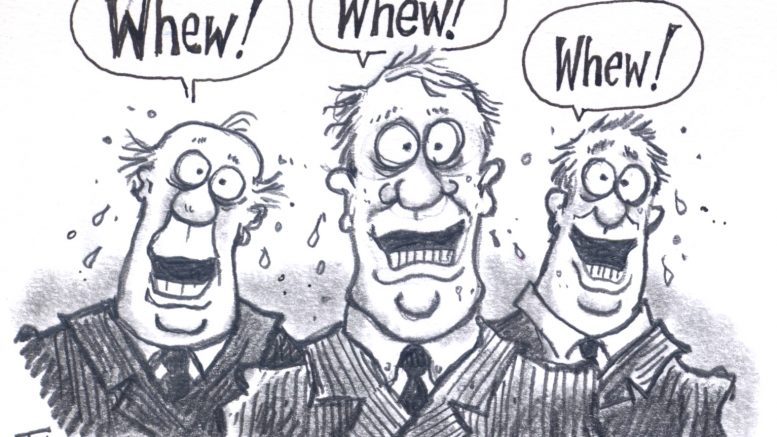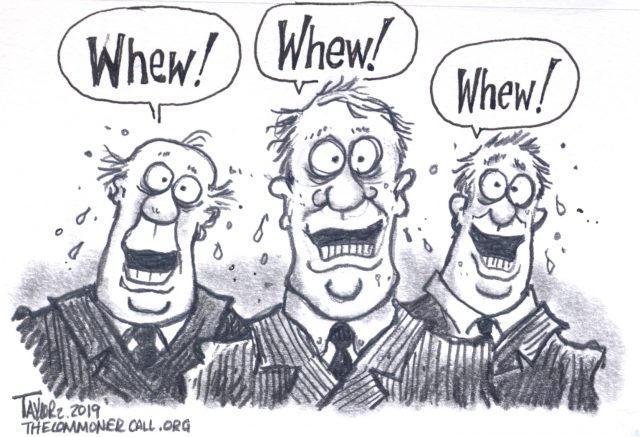The courthouse door was just slammed shut on workers and retirees whose pension plans get bilked.
By David Sirota
TMI (6/24/20)
In the 1987 classic film Wall Street, pension funds make a brief but important appearance, as Gordon Gekko hatches a plan to steal 6,000 airline workers’ retirement savings. An angry Bud Fox asks Gekko: “How much is enough?” — a question warning the audience about unbridled greed and the financial vipers in our midst.
Thirty-three years after the release of Wall Street, it seems the U.S. Supreme Court saw the film as a guidebook rather than a cautionary tale: In a landmark ruling last week, Brett Kavanaugh and his conservative cadre undermined workers and retirees who might try to stop Gekko’s scheme at their own companies.
In the process, the ruling may have short-circuited a separate case that Wall Street was fearing.
In the 1987 classic film Wall Street, pension funds make a brief but important appearance, as Gordon Gekko hatches a plan to steal 6,000 airline workers’ retirement savings. An angry Bud Fox asks Gekko: “How much is enough?” — a question warning the audience about unbridled greed and the financial vipers in our midst.
Thirty-three years after the release of Wall Street, it seems the U.S. Supreme Court saw the film as a guidebook rather than a cautionary tale: In a landmark ruling last week, Brett Kavanaugh and his conservative cadre undermined workers and retirees who might try to stop Gekko’s scheme at their own companies.
Protecting fraud and mismanagement
Some background: In the last two decades, class action lawsuits have forced large employers to pay out more than $6 billion in cases alleging fraud and mismanagement of workers’ retirement savings. At the same time, financial firms hired to manage that money have been skimming hundreds of billions of dollars of fees off the pension funds, while delivering subpar returns. Last week, one report found that private equity firms — which manage pension money — have raked in more than $230 billion of performance fees in 10 years, while delivering returns that did not substantially beat a low-fee stock index fund.
Preventing employers and financial firms from robbing workers’ pension funds is critical, because the consequences of inaction can be devastating. The more stealing, the more fees and the more underperformance, the more pressure there is to cut millions of workers’ promised benefits or have companies declare bankruptcy. In the case of public pension systems, benefits can be slashed or taxes can be raised on everyone to backfill the losses.
Enter the Supreme Court’s Thole v. U.S. Bank ruling.
In that case, the plaintiffs were two retired employees of the bank who alleged that the company engaged in self-dealing and inappropriately invested workers’ pension money in ways that allowed bank executives to pay “themselves excessive management fees… manipulate accounting rules, boost their reported incomes, inflate their stock prices, and exercise lucrative stock options to their own (and their shareholders’) benefit,” according to Supreme Court documents.
When the scheme produced a loss of more than $1 billion during the Great Recession, the plaintiffs sued to force U.S. Bank to pay $750 million back to the pension fund — a sum that they argued was the amount of losses that was above and beyond what a standard investment formula would have produced in the same time period.
Now here’s the punchline: Rather than weighing in on the allegations of theft, Kavanaugh and the other conservative justices slammed the courthouse door on the plaintiffs and every other plaintiff like them, thereby creating the conditions for an undeterrable crime spree.
“The Court’s Reasoning Allows Fiduciaries To Misuse Pension Funds”
Writing for the majority, Kavanaugh declared that “the plaintiffs themselves have no concrete stake in the lawsuit” and therefore have no standing to bring a case because they themselves did not (yet) see their own pension benefits reduced.
In other words, even if the plaintiffs can prove that the pension fund itself was illegally fleeced, the majority ruled that the plaintiffs have no right to sue unless and until they can prove their own promised retirement payments were reduced because of the wrongdoing.
This may sound superficially logical — after all, if someone’s retirement benefit wasn’t cut, how can they sue for losses?
But drill down a bit and you realize that in practice, the ruling creates a license for employers and financial managers to steal up to a certain level.
The court precedent effectively says that workers and retirees cannot sue for damages as long as an employer or a financial firm managing pension money steals less than an amount that totally bankrupts a pension plan to the point where current retirees get their benefits cut. They have no standing to sue, even if the theft has destabilized the pension system for the long haul.
That’s like saying that if your local bank manager is slowly draining your savings account, you can’t sue him until there’s literally no money left in your account, because up until that point, you still at least have enough cash in there to pay your monthly bills.
“The Court’s reasoning allows fiduciaries to misuse pension funds so long as the employer has a strong enough balance sheet during (or, as alleged here, because of ) the misbehavior,” wrote Justice Sonia Sotomayor in her dissent. “Indeed, the Court holds that the Constitution forbids retirees to remedy or prevent fiduciary breaches in federal court until their retirement plan or employer is on the brink of financial ruin.”
To be sure, pension systems themselves may still be able to sue when they are bilked by third-party financial firms. The systems could still argue that they were directly harmed and therefore have standing. But the new ruling disempowers workers and retirees from taking legal matters into their own hands — which is a big deal. …
Read The Rest And Two Video Clips
(Commoner Call cartoon by Mark L. Taylor, 2019. Open source and free for non-derivative use with link to www.thecommonercall.org )


